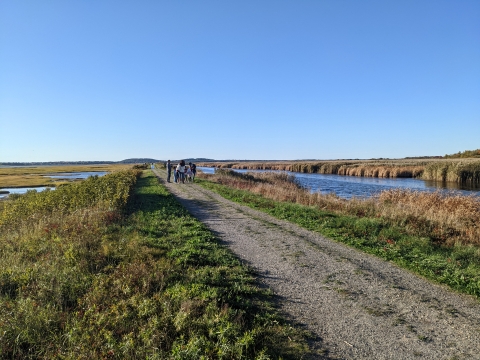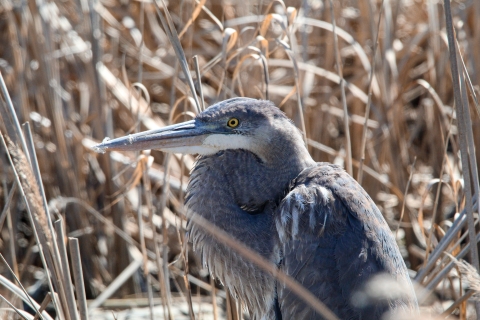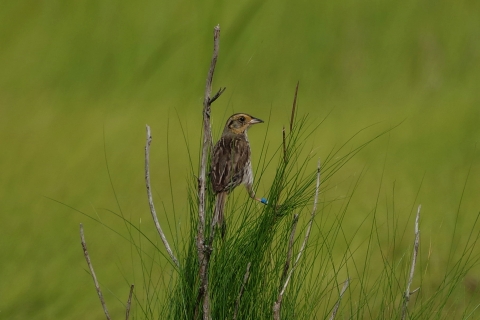Habitat Management Plan Overview
The Habitat Management Plan provides a long-term vision and specific guidance on managing priority species, habitats, and ecosystems at Parker River and Thacher Island National Wildlife Refuges. Accompanying documents include an Environmental Assessment (EA) that evaluates the potential environmental effects associated with implementing this HMP, and a Fire Management Plan (FMP) that specifies how fire may be used as a management tool to reduce fire hazards and meet habitat objectives.
A shift in management for this HMP includes restoring hydrology to over 3,000 acres of salt marsh salt marsh
Salt marshes are found in tidal areas near the coast, where freshwater mixes with saltwater.
Learn more about salt marsh , including the 266 acres of currently impounded waters that will be restored over time to salt marsh habitat at Parker River NWR. Chapter 4 of the HMP and the Environmental Assessment describe in detail the rationale and timeline for decommissioning the three impoundments to prevent an unplanned, catastrophic breach. Rising ambient and ocean temperatures, rising sea levels, increased frequency and intensity of storm surges, and other impacts from climate change climate change
Climate change includes both global warming driven by human-induced emissions of greenhouse gases and the resulting large-scale shifts in weather patterns. Though there have been previous periods of climatic change, since the mid-20th century humans have had an unprecedented impact on Earth's climate system and caused change on a global scale.
Learn more about climate change affect the adaptive capacity of coastal ecosystems such as those found at the refuge.
The HMP also focuses on protecting rare and endangered species, maintaining the health of barrier island ecosystems, and building climate resilience throughout the Parker River and Thacher Island Refuges by allowing for, or restoring, natural processes.
Purpose of the Habitat Management Plan
Numerous environmental conditions have changed on these refuges since the last HMP was completed in 2007. Unprecedented acceleration of marsh conversion and marsh loss is occurring in the Great Marsh, including on Parker River NWR. We are faced with the increasing challenge of managing the three refuge impoundments to meet biological objectives and a greater risk of catastrophic failure of the dikes during storm surges. Maintaining biological integrity, diversity, and environmental health on the refuges requires an increased focus on restoring ecological function and managing invasive plants to ensure successful regeneration of native plant communities that support present and future wildlife. Uncertain future conditions require us to use the full range of management tools including prescribed fire and restoring natural processes.
We incorporate prescribed fire as a tool for reintroducing natural disturbance regimes that have been largely eliminated in the Northeastern US, primarily in fire-adapted habitats: pitch pine forests, sandplain grasslands, managed fields, maritime shrubs, and forests. Eradicating and containing invasive plants is a strategy across all habitat types and is essential to maintaining biological integrity, diversity, and environmental health, benefiting migratory songbirds, bats, native plant communities, among other elements. Seasonal closures and other public access restrictions will be continued and modified as needed to protect nesting and migrating shorebirds and terns, rare toads, moths and butterflies, and rare and unique plant communities.
On Thacher Island we will maintain native plant communities and structure structure
Something temporarily or permanently constructed, built, or placed; and constructed of natural or manufactured parts including, but not limited to, a building, shed, cabin, porch, bridge, walkway, stair steps, sign, landing, platform, dock, rack, fence, telecommunication device, antennae, fish cleaning table, satellite dish/mount, or well head.
Learn more about structure in the rocky intertidal shore and maritime shrubland to benefit nesting shorebirds and terns and nesting and migrating songbirds. We will work with partners to assess the feasibility of establishing a population of New England cottontail to support regional captive rearing efforts to restore this native cottontail to the New England landscape.
Open Houses & Submitting a Public Comment
The draft HMP, EA, and FMP are open for public comment from September 28 to October 28. Comments can be submitted in via email to parkerriver@fws.gov, or in person at one of the two open house sessions scheduled for October 11 at 12:30pm and 6pm at Refuge Visitor Center at 6 Plum Island Turnpike, Newburyport, MA.
FAQ
What is the action taking place?
US Fish and Wildlife Service is opening a 30-day public comment period (September 28 to October 28) for the draft Habitat Management Plan for Parker River National Wildlife Refuge and Thacher Island National Wildlife Refuges. Associated Environmental Assessment and Fire Management Plan is incorporated in the Plan.
Why is the action being taken?
Service policy requires each refuge to have an HMP to guide management actions that will achieve the Refuge’s established purpose, fulfill the missions of the Refuge System and the Service, and meets other Congressional mandates. Many environmental factors related to climate impacts have changed since the 2007 HMP, requiring shifts in management strategies for some habitats.
What is the major difference between 2023 and 2007 HMP?
To meet the challenges of a shifting barrier island system in the face of climate impacts, this HMP focuses on restoring sustaining populations of rare species, maintaining the health of barrier island ecosystems, restoring natural process to build climate resilience, and addressing anthropogenic threats that exacerbate future climate change impacts. A major focus is restoring hydrology to over 3,000 acres of salt marsh to allow it to adapt to sea level rise and storm surge. This includes restoring the 3 impoundments (266 acres) to salt marsh habitat over time in order to prevent unplanned catastrophic breach. Chapter 4 of the HMP and the Environmental Assessment describe in detail the rationale and timeline for decommissioning the three impoundments.
Why are you restoring the impoundments and what would they look like?
Since being isolated from tidal flooding in the 1950s, the three impoundments have lost 1 to 1.5 feet of elevation relative to the adjacent salt marshes. We expect this elevation gap to increase with sea level rise, threatening the future capacity to manage water levels in the impoundments. The risk of catastrophic failure increases with increasing storm frequency and intensity, potentially resulting in sudden marsh collapse and dead zones without oxygen.
For these areas to persist, we need to restore the tidal flooding, ebbing, and sedimentation that will allow these marsh areas to keep up with sea level rise. This action will convert these artificial fresh or brackish marshes back to salt marsh systems.
We expect Stage Island and Bill Forward Pool to be restored to Low Marsh, dominated by tall Spartina alterniflora that is flooded daily. North Pool would convert to a mix of High and Low Marsh (figures on p17-19 of EA), with some parts flooding daily and others flooding once a month. Over time, we would expect the restored marsh to gain elevation, and convert to more High Marsh.
Where would birds that use the impoundments go if they are restored to salt marsh?
Some birds, such as shorebirds and waterfowl would continue to use the restored salt marsh. In the beginning, more shorebirds would probably use the site as there will be large areas of tidal flats that are flooded regularly. As these areas revegetate, waterfowl use will increase, as will some secretive marsh birds, like Clapper Rail, American Bittern, King Rail and Marsh Wren. These areas may also support the Federally listed Black Rail in future years as species move north.
Except where the cut needs to be made to restore tidal flow, the impoundment dikes will stay in place and continue to provide elevated viewing opportunities. Birdwatching opportunities will be different post restoration. Least Bitterns and Virginia Rail, which currently nest in North Pool, will not use the restored salt marsh habitat, other rails, herons, and bitterns will use the restored site.
Has the refuge considered building the dike larger and taller to protect the impoundment?
According to Coastal Geomorphologist Refuge staff consulted, the dike does not protect the impoundment from storm breach. Instead, the salt marsh outside the dike is slowing down wave action and protecting both the dike and the impoundment. If this salt marsh gets narrower, the risk of catastrophic failure will significantly increase. There are signs that the dike is at risk of unplanned breach: (1) there is significant erosion along the tidal creek near the water control structure; and (2) in Nor’easter Grayson, storm flooding topped the North Pool dike.
What is the timeline for restoring impoundments?
The timing of the impoundment restoration will depend on many factors, including securing funding and necessary permits, staffing capacity, and the threat of catastrophic failure. Refuge staff proposes to restore the Stage Island Impoundment by 2027.
The plan aims to restore Bill Forward and North Pool Impoundment by 2035, but the exact timing may be adjusted based on results of the Stage Island restoration and vulnerability of the impoundments and relative elevation difference between the impoundments and adjacent salt marsh.
Why are you including fire in the management plan?
Whether naturally occurring or assisted by Indigenous people, fire was part of the coastal New England landscape for thousands of years prior to European settlement. Some of the habitats on the Refuge - including pitch pines and sandplain grasslands - are fire adapted and require recurring fire to maintain its plant community. When applied correctly, fire can be an important tool to manage invasive plants, set back succession, recycle nutrients, and encourage recruitment of new plants. Periodic prescribed fire also reduces the risk of wildfires. The Fire Management Plan is the first step to allowing prescribed fire on Refuges and is comprehensive to provide the full range of management options for future years. Prior to using prescribed fire, a Prescribed Fire Plan will be developed with annual prescriptions and further details. There are no plans for prescribed fire on Thacher Island for the foreseeable future.
Where can I read the draft HMP/EA/FMP?
Digital copies of the draft Habitat Management Plan, Environmental Assessment, and Fire Management Plan can be accessed by clicking the plan names or visiting our online library here. Use the Bookmark panel in Adobe to easily navigate to the different sections of the document. The documents were created to be 508-compliant. If you need assistance reading or understanding any of the figures, tables, or maps, please contact the Parker River National Wildlife Refuge at parkerriver@fws.gov.
Hard Copies of these documents are also available at:
Refuge headquarters at 6 Plum Island Turnpike, Newburyport
Newburyport City Hall, 60 Pleasant Street, Newburyport
Newbury Town Hall, 12 Kent Street, Newbury
Rowley Town Hall, Select Board’s Office, 139 Main St (Rt 1A), Rowley
Ipswich Public Library, 25 N Main St, Ipswich
Rockport Town Hall, Town Administrator’s Office, 34 Boardway, Rockport






